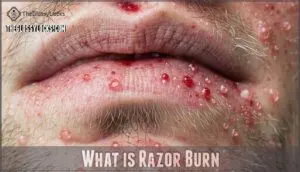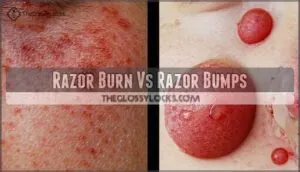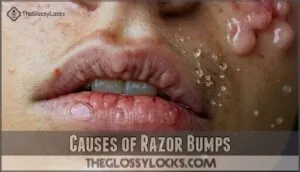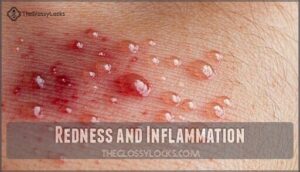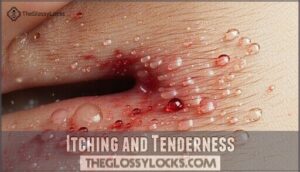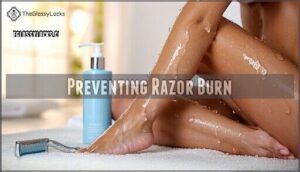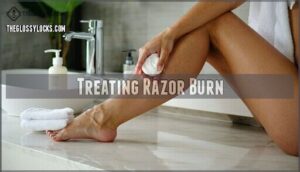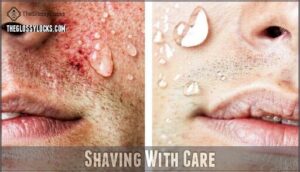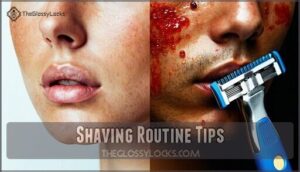This site is supported by our readers. We may earn a commission, at no cost to you, if you purchase through links.
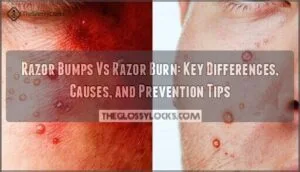
Razor burn hits fast, leaving behind red, irritated patches that sting like a bad sunburn. It’s often caused by dry shaving, dull blades, or rushing through your shave.
Razor bumps, on the other hand, are sneaky. They happen when shaved hairs curl back into your skin, creating itchy, inflamed, pimple-like bumps. It’s more common with coarse or curly hair.
Both might have you second-guessing your shaving routine, but with the right prep and technique, you can avoid the blame game altogether. The secret? Start shaving smarter.
Table Of Contents
- Key Takeaways
- What is Razor Burn
- Razor Burn Vs Razor Bumps
- Causes of Razor Bumps
- Symptoms of Razor Bumps
- Preventing Razor Burn
- Treating Razor Burn
- Razor Bump Prevention
- Shaving Routine Tips
- Managing Razor Burn
- Frequently Asked Questions (FAQs)
- How to tell the difference between razor burn and razor bumps?
- How do you get rid of razor bumps down there asap?
- How to tell the difference between razor bumps and folliculitis?
- Can women get razor bumps on their legs?
- How long do razor bumps typically last?
- Are electric razors less likely to cause irritation?
- Can certain foods worsen razor burn symptoms?
- Is it safe to shave over existing razor bumps?
- Can diet impact razor bump or burn formation?
- What role does water temperature play in shaving?
- Conclusion
Key Takeaways
- Know the difference: Razor burn causes red, itchy irritation right after shaving, while razor bumps are inflamed, pimple-like bumps from ingrown hairs.
- Prevent razor burn by using sharp razors, shaving with the grain, and prepping your skin with warm water and quality shaving cream.
- Manage razor bumps by gently exfoliating, moisturizing, and opting for soothing products like aloe vera or hydrocortisone cream.
- Avoid shaving over existing razor bumps or burns to prevent further irritation and give your skin time to heal.
What is Razor Burn
Razor burn happens when your skin becomes irritated after shaving, leaving it red, itchy, and uncomfortable.
A fiery reminder that shaving mistakes can turn smooth skin dreams into red, itchy reality—razor burn is common but conquerable!
It’s a common issue that can show up minutes after shaving, often feeling like a fiery reminder to adjust your routine.
Symptoms of Razor Burn
Razor burn symptoms show up fast—often minutes post-shave—and can include:
- Itchiness severity: Mild to intense itching that feels relentless.
- Burning sensation: Like sunburn but sneakier.
- Redness appearance: Blotches or streaks across shaved areas.
- Swelling duration: Temporary puffiness that’s annoying yet harmless.
- Skin inflammation: Small clusters of red bumps, often mistaken for a rash.
Stay calm, it’s common!
Causes of Razor Burn
Shaving mistakes can quickly lead to skin inflammation. Using dull blades causes more friction, leading to irritation.
Dry shaving is another culprit—it drags on your skin without protection. Poor preparation, like skipping shaving cream, also magnifies shaving irritation.
Shaving against the grain or using irritating products can worsen razor burn. Proper shaving techniques make a big difference.
| Cause | Effect | Solution |
|---|---|---|
| Dull Blades | Increased friction and irritation | Use sharp, clean razors |
| Dry Shaving | Dragging, leading to razor burn | Always use shaving cream |
| Poor Preparation | Enhances irritation | Prep skin with warm water |
| Shaving Direction | Against grain, worsens inflammation | Shave with the grain |
| Product Irritation | Triggers sensitivity | Opt for fragrance-free products |
Proper shaving techniques include using sharp blades, shaving with the grain, and preparing the skin correctly to minimize irritation and inflammation. By following these guidelines, individuals can reduce their risk of experiencing razor burn and improve their overall shaving experience.
Common Affected Areas
Itchy redness or splotchy streaks often show up in spots where skin meets a razor most frequently.
Legs and razor burn are familiar foes, while underarm sensitivity or bikini line razor bumps cause discomfort.
Neck shaving invites issues like Pseudofolliculitis Barbae, and the pubic area’s delicate skin easily gets irritated.
Facial irritation can linger, especially around the jawline, and these areas are prone to razor burn.
Razor Burn Vs Razor Bumps
Sometimes, it’s tricky telling razor burn from razor bumps.
Razor burn fades fast, but razor bumps stick around, reminding you why proper shaving techniques truly matter.
Razor burn shows up as red, itchy patches or a shaving rash, often disappearing in days.
Razor bumps, tied to Pseudofolliculitis Barbae, involve ingrown hairs that cause raised, inflamed bumps and may linger longer.
Check this table to see the differences clearly:
| Feature | Razor Burn | Razor Bumps |
|---|---|---|
| Appearance | Red patches or rash | Raised, inflamed bumps |
| Severity | Mild discomfort | Can be more severe |
| Healing Timeline | A few days | Weeks, possible scarring |
Take note—bumps need long-term solutions!
Causes of Razor Bumps
Razor bumps happen when shaved hairs curl back into your skin, causing irritation.
If you’ve got curly hair or use poor shaving techniques, you’re more likely to face this pesky issue.
Ingrown Hairs
Ingrown hairs happen when hair curls back into the skin or struggles to break through, often leading to razor bumps (Pseudofolliculitis Barbae).
To prevent scarring, exfoliate gently to clear clogged hair follicles.
Removing ingrown hairs safely may involve tweezers or laser treatment. Always shave in the hair growth direction, use proper techniques, and hydrate well to avoid razor burn.
Curly Hair Issues
Why does curly hair often lead to razor bumps? Curly hair texture increases the risk of follicle distortion, causing ingrown hairs.
Coarse or kinky hair curls back into the skin, triggering issues like Pseudofolliculitis Barbae. The severity varies, but using solutions like exfoliating and gentle shaving can help.
Genetic factors substantially influence hair texture and curl patterns. Embrace proper care for curly hair and avoid the burn—literally, with gentle shaving!
Shaving Techniques
Shaving techniques matter more than you’d think.
Using the right blade angle reduces irritation, while stretching your skin helps avoid nicks. Short stroke lengths control razor pressure, giving you a smoother shave.
Multi-pass shaving is okay, but keep it gentle. Always use shaving cream to reduce friction and follow a consistent shaving routine.
These shaving tips prevent pesky razor bumps!
Symptoms of Razor Bumps
You’ll notice razor bumps as small, raised red spots that often feel tender or itchy.
They can sometimes appear with pus-filled heads or a hair trapped inside, making shaving a frustrating experience.
Redness and Inflammation
Inflammation from razor bumps can turn your skin into an unwanted shade of red, often paired with swelling.
The duration and severity depend on how sensitive your skin is and any underlying conditions.
Here’s what to watch for:
- Persistent skin redness.
- Swelling near hair follicles.
- Warmth in affected areas.
- Small, raised bumps.
- Visible irritation after shaving.
Itching and Tenderness
Itching and tenderness from razor bumps can be infuriating.
You might feel like tiny ants are dancing on your skin! To ease discomfort, try these soothing techniques like cool compresses or applying aloe vera. Topical relief creams also work wonders.
Here’s a quick comparison:
| Symptom | Severity Levels | Preventative Measures |
|---|---|---|
| Itching | Mild to Severe | Use sharp razors, shave gently |
| Tenderness | Mild to Moderate | Moisturize post-shave |
| Skin Irritation | Mild | Avoid shaving too frequently |
Pus-Filled Bumps
Pus-filled bumps are common signs of razor bumps and often indicate mild folliculitis or infection.
These bumps can vary in size, redness, and pain levels, sometimes leaving scarring potential if scratched.
Infection indicators include swelling around the bump and visible pus.
Treatment options like warm compresses, soothing creams, and proper hygiene help manage symptoms and prevent worsening.
Avoid squeezing bumps.
Preventing Razor Burn
Preventing razor burn starts with using proper shaving techniques, sharp razors, and prepping your skin beforehand.
It’s all about reducing friction and irritation, so your skin feels smooth instead of looking like it just lost a battle with a cheese grater.
Proper Shaving Techniques
To prevent razor burn, focus on the right shaving techniques.
Hold your razor at the correct blade angle (about 30 degrees) and avoid pressing too hard; light strokes are key.
Stretch your skin gently for a smoother surface and shave in the direction of hair growth.
Use short stroke lengths and apply a quality shaving gel to minimize friction.
Choosing Right Razors
When choosing razors, pick one with multiple blades for a smoother shave and fewer strokes.
If you’ve got sensitive skin, stick to single-blade razors or options labeled for gentle shaving.
Look for ergonomic designs for comfort and grip. Replace dull blades often—neglecting razor maintenance can lead to razor bumps or burn.
Consider using specialized razors for burn to minimize irritation. Quality shaving products complement razor performance perfectly!
Pre-Shave Preparation
Preparation is key to a smooth shave.
Start with skin hydration using warm compresses to soften hair and open pores.
Exfoliation benefits include removing dead skin and reducing blockages.
Choose shaving products wisely—sensitive skin needs gentle creams.
Stick to quality shaving tools for a better outcome.
A thoughtful shaving routine guarantees comfort and minimizes razor burn risk.
Using a quality pre-shave lotion can further reduce irritation.
Treating Razor Burn
Treating razor burn doesn’t have to be complicated, and you’ve got plenty of options to soothe irritated skin.
From simple home remedies to store-bought creams, there’s a solution to get your skin back on track quickly, with plenty of options.
Home Remedies
Got razor burn? A few simple remedies can soothe and heal.
- Use natural oils like coconut or olive to moisturize and calm irritation.
- Try oatmeal baths for burn relief and to alleviate itching from razor bumps or ingrown hairs.
- Apply aloe vera or a cool compress to reduce redness and inflammation, offering instant comfort.
Over-the-Counter Solutions
Sometimes, homemade fixes aren’t enough.
OTC creams like hydrocortisone ease burn relief, while salicylic acid clears pores to stop razor bumps.
Antiseptic washes help prevent infections, and exfoliating agents reduce ingrown hairs.
Pain relievers soothe irritation fast.
| Product Type | Purpose | Key Ingredient | Benefits | Example Uses |
|---|---|---|---|---|
| OTC Creams | Burn relief | Hydrocortisone | Reduces redness, itching | Razor burn |
| Topical Antibiotics | Infection prevention | Benzoyl peroxide | Combats bacteria | Razor bumps |
| Antiseptic Washes | Clean surface cuts | Witch hazel | Calms inflammation, hydrates | Post-shave cleaning |
| Exfoliating Agents | Remove dead skin | Glycolic acid | Prevents clogged follicles | Ingrown hair treatment |
| Pain Relievers | Soothe irritation | Lidocaine | Numbs discomfort | Razor burn or bumps |
For a variety of options, consider exploring different hydrocortisone cream products.
Medical Advice
If razor burn or razor bumps persist or show signs of infection, it’s time to consult a dermatologist.
They might suggest prescription creams or antibiotics to combat folliculitis and prevent scarring.
- When to Worry: Prolonged redness, pus, or severe pain.
- Prescription Guidance: Creams for inflammation or antibiotics for infection.
- Dermatology Tip: Prioritize expert advice for stubborn skin conditions.
Anyone can develop them after hair removal methods like shaving, waxing, or plucking.
Razor Bump Prevention
Preventing razor bumps is all about being kind to your skin during and after shaving.
By exfoliating regularly, shaving gently, and keeping your skin moisturized, you can avoid those irritating bumps that seem to appear out of nowhere.
You can achieve this by following a simple skincare routine that includes exfoliating regularly.
Exfoliating Skin
Exfoliating skin is a small change that packs a punch in preventing razor bumps and burns.
Use gentle physical scrubs or chemical exfoliants based on your skin type.
Overdoing it can backfire, so limit exfoliation frequency to 2-3 times weekly.
Many people find success with gentle exfoliating products.
Here’s a quick guide:
| Method | Best For | How Often | Key Benefit |
|---|---|---|---|
| Physical scrubs | Normal/Oily Skin | 2-3 times/week | Removes dead skin |
| Chemical exfoliants | Sensitive Skin | 1-2 times/week | Dissolves dead cells |
| Exfoliating gloves | Dry Skin | 1-2 times/week | Boosts circulation |
| Enzyme cleansers | Acne-Prone Skin | 2 times/week | Gentle exfoliation |
The key to successful exfoliation is finding the right balance for your skin type and needs, and being consistent with your exfoliating routine to achieve the best results, including reducing razor burns and improving overall skin health with gentle care.
Shaving With Care
When shaving, the right approach saves your skin—and sanity.
Avoid razor bumps and ingrown hairs with these tips:
- Blade Maintenance: Use sharp, clean blades; ditch old, dull ones.
- Shaving Direction: Go with hair growth, not against it.
- Sensitive Areas: Slow down and use hydrating products for trouble spots.
A gentle shaving routine makes all the difference!
Post-Shave Care
A solid post-shave care routine can save your skin from razor burn and bumps.
Focus on hydration—apply soothing balms or cooling gels to calm irritation.
Avoiding irritants like alcohol-based products helps protect your skin barrier. Moisturizing after shaving promotes healing while preventing bumps.
Treating razor burn starts with gentle care, so skip tight clothing and let your skin breathe.
Shaving Routine Tips
Your shaving routine plays a big role in preventing razor burn and bumps, so it’s worth getting it right.
By making a few small changes, like knowing your skin type and adjusting shaving habits, you can keep your skin smooth and irritation-free.
Identifying Skin Type
Wondering how to identify your skin type? It’s easier than you think!
Use these tips to make skin type considerations part of your routine:
- Take a Skin Type Quiz or consult a dermatologist.
- Check for skin sensitivity like redness or itching after using new products.
- Observe oily or dry areas 30 minutes post-cleansing.
- Factor in lifestyle and product ingredients!
Adjusting Shaving Frequency
Adjusting your shaving frequency depends on hair growth patterns and skin sensitivity levels.
Shaving too often irritates your skin, while waiting too long can cause ingrown hairs.
Find balance based on your hair growth cycle and seasonal shaving changes.
| Frequency | Impact on Skin | Best Practice |
|---|---|---|
| Daily | High risk of razor burn | Suitable for light, slow hair growth |
| Every 2-3 days | Moderate irritation | Ideal for avoiding razor bumps |
| Weekly | Minimal irritation | Best for sensitive skin types |
Post-Shave Moisturizing
After setting your shaving frequency, focus on post-shave care.
Applying a moisturizer packed with soothing ingredients like aloe vera or shea butter helps calm sensitive skin.
Skin hydration reduces redness and itching while supporting long-term effects like smoother texture.
Avoid alcohol-based products; instead, choose skin moisturizers designed for hydration benefits.
Consistent moisturization keeps your skin happy and shaving irritation-free!
Managing Razor Burn
You can tackle razor burn by calming your skin and preventing further irritation.
A few simple changes in your routine, like using soothing products and letting your skin recover, can make a big difference.
Reducing Inflammation
When you’ve got razor burn causing inflammation, treating it quickly can make all the difference.
Here’s how:
- Apply cool compresses to calm irritated spots.
- Use hydrocortisone cream or topical steroids sparingly for quick relief.
- Try natural remedies like aloe vera or anti-inflammatories to restore your skin barrier.
Your skin deserves some TLC—not extra irritation!
Soothing Itching
If itching keeps bothering you after razor burn, try simple tricks!
A cooling compress works wonders for instant relief.
Aloe application calms inflammation, while adding a soothing touch.
For extra comfort, oatmeal baths reduce irritation.
Tea tree oil and hydrocortisone cream can help with stubborn razor bumps and itching.
A little care goes a long way for happy skin!
Promoting Skin Healing
Healing your skin after razor burn isn’t complicated.
Start with natural remedies like aloe vera or oatmeal baths to soothe inflammation. Hydration is key—moisturize with antioxidant-rich products to promote scar prevention.
Gentle exfoliation helps remove dead skin cells and support recovery. Dull razors cause irritation, so be sure to replace blades regularly.
Avoid scratching; let your skin breathe. These tips also help with razor bumps and irritation while maintaining healthy skin.
Frequently Asked Questions (FAQs)
How to tell the difference between razor burn and razor bumps?
When the razor meets your skin, razor burn shows up fast as red, itchy streaks or blotches.
Razor bumps, however, take time, forming inflamed, pimple-like clusters from ingrown hairs curling back into the skin, which can be considered a complete concept related to the issue.
How do you get rid of razor bumps down there asap?
Tackle those razor bumps fast by gently exfoliating the area to free trapped hairs.
Apply aloe vera or hydrocortisone cream to soothe inflammation.
Avoid tight clothing, and skip shaving until the skin heals completely.
How to tell the difference between razor bumps and folliculitis?
Folliculitis involves infected or inflamed hair follicles, often causing pus-filled bumps or tenderness.
While razor bumps happen when shaved hairs curl back into the skin.
Folliculitis can feel hotter or more tender, needing medical attention sometimes, which is a key distinction from razor bumps, involving inflamed hair follicles.
Can women get razor bumps on their legs?
Yes, women can definitely get razor bumps on their legs.
These happen when shaved hairs curl back into the skin, causing irritation.
It’s more common with thick or curly hair and improper shaving techniques.
How long do razor bumps typically last?
Those pesky bumps usually clear up in 3 to 7 days, depending on your skin type and care routine.
Keep the area clean, moisturized, and avoid shaving over bumps to speed up healing.
Are electric razors less likely to cause irritation?
Electric razors are generally gentler on your skin since they don’t shave as closely as traditional razors.
This reduces the risk of irritation, but maintaining clean blades and proper technique is still essential for comfort.
Can certain foods worsen razor burn symptoms?
Certain spicy or high-sugar foods can fuel inflammation, potentially worsening razor burn.
Drinking plenty of water and eating anti-inflammatory foods like leafy greens, berries, and fatty fish can help your skin heal faster and stay calm, which is crucial for reducing inflammation.
Is it safe to shave over existing razor bumps?
Shaving over razor bumps isn’t a good idea.
You risk irritating the skin further and causing infections.
Let your skin heal first—consider using soothing products like aloe vera or hydrocortisone cream to reduce inflammation.
Can diet impact razor bump or burn formation?
You are what you eat, even for your skin.
A balanced diet with antioxidants, vitamins, and hydration can reduce inflammation, supporting healthy skin.
Skip sugary, greasy foods—they may trigger irritation or slow healing.
What role does water temperature play in shaving?
Warm water softens hair and opens pores, making shaving smoother and less irritating.
Cold water tightens the skin, increasing resistance, while hot water can dry skin out.
Lukewarm water? It’s the sweet spot!
Conclusion
It’s no coincidence that knowing the difference between razor bumps and razor burn leads to healthier, irritant-free skin.
By understanding their unique causes—like improper shaving for razor burn or ingrown hairs for razor bumps—you can finally ditch post-shave discomfort.
Focus on expert shaving techniques, exfoliate regularly, and don’t skimp on post-shave care.
A smarter routine avoids itchy bumps and painful burns altogether, and by shave smarter and let your skin thank you by staying smooth, clear, and confident!

